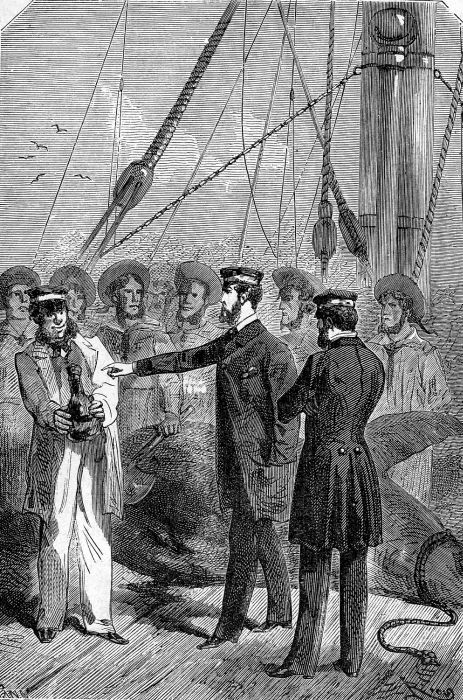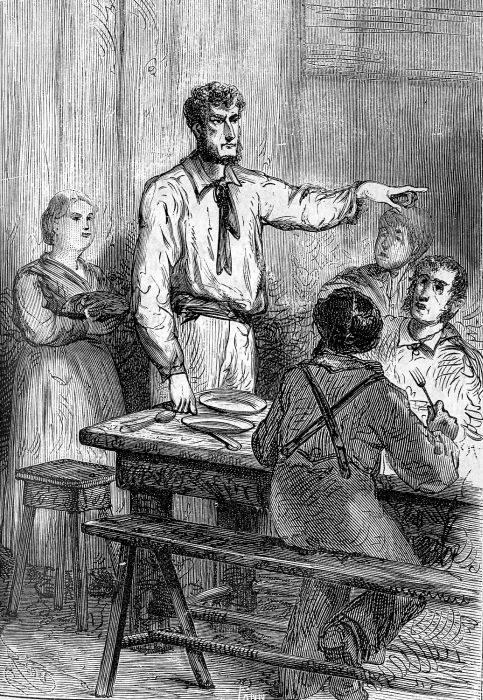|
Lord Glenarvan
Lord Glenarvan is a fictional character that appears in Jules Verne's 1868 novel ''In Search of the Castaways'' and then briefly appears in ''The Mysterious Island'' (1875). He is a wealthy Scottish noble married to Lady Glenarvan. Fictional appearances Lord Glenarvan owns a yacht called the ''Duncan'', which he uses to help find Captain Grant of the ''Britannia'', who is being sought by his children Robert and Mary. After many travels and misfortunes he and his crew eventually finds the captain in the conclusion of ''In Search of the Castaways''. In ''The Mysterious Island'', Lord Glenarvan uses the ''Duncan'' to save castaways and the repentant criminal Tom Ayrton on the fictional Lincoln Island. In ''Among the Cannibals'', Lord Glenarvan threatens to kill his wife to prevent her from being taken captive by a group of Maori. Moffat interprets this scene as an example of the "European fear" of "the contamination and despoliation of pure and virtuous European women". Receptio ... [...More Info...] [...Related Items...] OR: [Wikipedia] [Google] [Baidu] |
Voyages Extraordinaires
The ''Voyages extraordinaires'' (; ) is a collection or sequence of novels and short stories by the French writer Jules Verne. Fifty-four of these novels were originally published between 1863 and 1905, during the author's lifetime, and eight additional novels were published posthumously. The posthumous novels were published under Jules Verne's name, but had been extensively altered or, in one case, completely written by his son Michel Verne. According to Verne's editor Pierre-Jules Hetzel, the goal of the ''Voyages'' was "to outline all the geographical, geological, physical, historical and astronomical knowledge amassed by modern science and to recount, in an entertaining and picturesque format ... the history of the universe." Verne's meticulous attention to detail and scientific trivia, coupled with his sense of wonder and exploration, form the backbone of the ''Voyages''. Part of the reason for the broad appeal of his work was the sense that the reader could really lea ... [...More Info...] [...Related Items...] OR: [Wikipedia] [Google] [Baidu] |
Les Enfants Du Capitaine Grant
''In Search of the Castaways'' (french: Les Enfants du capitaine Grant, lit=The Children of Captain Grant) is a novel by the French writer Jules Verne, published in 1867–68. The original edition, published by Hetzel, contains a number of illustrations by Édouard Riou. In 1876, it was republished by George Routledge & Sons as a three volume set titled ''A Voyage Round The World''. The three volumes were subtitled ''South America'', ''Australia'', and ''New Zealand''. As often with Verne, English translations have appeared under different names; another edition has the overall title ''Captain Grant's Children'' and has two volumes subtitled ''The Mysterious Document'' and ''Among the Cannibals''. Plot summary The book tells the story of the quest for Captain Grant of the ''Britannia''. After finding a bottle the captain had cast into the ocean after the ''Britannia'' is shipwrecked, Lord and Lady Glenarvan of Scotland contact Mary and Robert, the young daughter and son of Cap ... [...More Info...] [...Related Items...] OR: [Wikipedia] [Google] [Baidu] |
L'Île Mystérieuse
''The Mysterious Island'' (french: L'Île mystérieuse) is a novel by Jules Verne, published in 1875. The original edition, published by Hetzel, contains a number of illustrations by Jules Férat. The novel is a crossover sequel to Verne's famous ''Twenty Thousand Leagues Under the Seas'' (1870) and ''In Search of the Castaways'' (1867–68), though its themes are vastly different from those books. An early draft of the novel, initially rejected by Verne's publisher and wholly reconceived before publication, was titled ''Shipwrecked Family: Marooned with Uncle Robinson'', seen as indicating the influence of the novels ''Robinson Crusoe'' and ''The Swiss Family Robinson''. Verne developed a similar theme in his later novel, ''Godfrey Morgan'' (French: ''L'École des Robinsons'', 1882). The chronology of ''The Mysterious Island'' is incompatible with that of the original ''Twenty Thousand Leagues Under the Sea'', whose plot begins in 1866, while ''The Mysterious Island'' begins d ... [...More Info...] [...Related Items...] OR: [Wikipedia] [Google] [Baidu] |
Jules Verne
Jules Gabriel Verne (;''Longman Pronunciation Dictionary''. ; 8 February 1828 – 24 March 1905) was a French novelist, poet, and playwright. His collaboration with the publisher Pierre-Jules Hetzel led to the creation of the ''Voyages extraordinaires'', a series of bestselling adventure novels including ''Journey to the Center of the Earth'' (1864), ''Twenty Thousand Leagues Under the Seas'' (1870), and '' Around the World in Eighty Days'' (1872). His novels, always well documented, are generally set in the second half of the 19th century, taking into account the technological advances of the time. In addition to his novels, he wrote numerous plays, short stories, autobiographical accounts, poetry, songs and scientific, artistic and literary studies. His work has been adapted for film and television since the beginning of cinema, as well as for comic books, theater, opera, music and video games. Verne is considered to be an important author in France and most of Europe, where ... [...More Info...] [...Related Items...] OR: [Wikipedia] [Google] [Baidu] |
Scottish People
The Scots ( sco, Scots Fowk; gd, Albannaich) are an ethnic group and nation native to Scotland. Historically, they emerged in the early Middle Ages from an amalgamation of two Celtic-speaking peoples, the Picts and Gaels, who founded the Kingdom of Scotland (or ''Alba'') in the 9th century. In the following two centuries, the Celtic-speaking Cumbrians of Strathclyde and the Germanic-speaking Angles of north Northumbria became part of Scotland. In the High Middle Ages, during the 12th-century Davidian Revolution, small numbers of Norman nobles migrated to the Lowlands. In the 13th century, the Norse-Gaels of the Western Isles became part of Scotland, followed by the Norse of the Northern Isles in the 15th century. In modern usage, "Scottish people" or "Scots" refers to anyone whose linguistic, cultural, family ancestral or genetic origins are from Scotland. The Latin word ''Scoti'' originally referred to the Gaels, but came to describe all inhabitants of Scotland. Cons ... [...More Info...] [...Related Items...] OR: [Wikipedia] [Google] [Baidu] |
In Search Of The Castaways
''In Search of the Castaways'' (french: Les Enfants du capitaine Grant, lit=The Children of Captain Grant) is a novel by the French writer Jules Verne, published in 1867–68. The original edition, published by Hetzel, contains a number of illustrations by Édouard Riou. In 1876, it was republished by George Routledge & Sons as a three volume set titled ''A Voyage Round The World''. The three volumes were subtitled ''South America'', ''Australia'', and ''New Zealand''. As often with Verne, English translations have appeared under different names; another edition has the overall title ''Captain Grant's Children'' and has two volumes subtitled ''The Mysterious Document'' and ''Among the Cannibals''. Plot summary The book tells the story of the quest for Captain Grant of the ''Britannia''. After finding a bottle the captain had cast into the ocean after the ''Britannia'' is shipwrecked, Lord and Lady Glenarvan of Scotland contact Mary and Robert, the young daughter and son of Cap ... [...More Info...] [...Related Items...] OR: [Wikipedia] [Google] [Baidu] |
The Mysterious Island
''The Mysterious Island'' (french: L'Île mystérieuse) is a novel by Jules Verne, published in 1875. The original edition, published by Hetzel, contains a number of illustrations by Jules Férat. The novel is a crossover sequel to Verne's famous ''Twenty Thousand Leagues Under the Seas'' (1870) and ''In Search of the Castaways'' (1867–68), though its themes are vastly different from those books. An early draft of the novel, initially rejected by Verne's publisher and wholly reconceived before publication, was titled ''Shipwrecked Family: Marooned with Uncle Robinson'', seen as indicating the influence of the novels ''Robinson Crusoe'' and ''The Swiss Family Robinson''. Verne developed a similar theme in his later novel, ''Godfrey Morgan'' (French: ''L'École des Robinsons'', 1882). The chronology of ''The Mysterious Island'' is incompatible with that of the original ''Twenty Thousand Leagues Under the Sea'', whose plot begins in 1866, while ''The Mysterious Island'' begins d ... [...More Info...] [...Related Items...] OR: [Wikipedia] [Google] [Baidu] |
Tom Ayrton
Tom Ayrton is a fictional character who appears in two novels by French author Jules Verne. He is first introduced as a major character in the novel ''In Search of the Castaways'' (1867–1868). He then reappears in a later novel, ''The Mysterious Island'' (1874), in which his fate, left unknown at the ending of the previous novel, is resolved, and during the course of which his character undergoes change and achieves a redemption. Biography ''In Search of the Castaways'' A Scottish able seaman, Ayrton served as quartermaster on board the three-mast ship ''Britannia'', under the command of Captain Harry Grant. Differing opinions and extreme disputes with Grant led Ayrton to attempt leading a mutiny, the failure of which ended in his being expelled from the ship. Left behind alone on Australian shores, Ayrton learned nothing of the calamity that soon befell Grant's ship and crew. Teaming up with a band of escaped convicts, Ayrton began a life of crime around Australia, becoming ... [...More Info...] [...Related Items...] OR: [Wikipedia] [Google] [Baidu] |
Colonialism
Colonialism is a practice or policy of control by one people or power over other people or areas, often by establishing colonies and generally with the aim of economic dominance. In the process of colonisation, colonisers may impose their religion, language, economics, and other cultural practices. The foreign administrators rule the territory in pursuit of their interests, seeking to benefit from the colonised region's people and resources. It is associated with but distinct from imperialism. Though colonialism has existed since ancient times, the concept is most strongly associated with the European colonial period starting with the 15th century when some European states established colonising empires. At first, European colonising countries followed policies of mercantilism, aiming to strengthen the home-country economy, so agreements usually restricted the colony to trading only with the metropole (mother country). By the mid-19th century, the British Empire gave up me ... [...More Info...] [...Related Items...] OR: [Wikipedia] [Google] [Baidu] |
Stanford University Press
Stanford University Press (SUP) is the publishing house of Stanford University. It is one of the oldest academic presses in the United States and the first university press to be established on the West Coast. It was among the presses officially admitted to the Association of American University Presses (now the Association of University Presses) at the organization's founding, in 1937, and is one of twenty-two current member presses from that original group. The press publishes 130 books per year across the humanities, social sciences, and business, and has more than 3,500 titles in print. History David Starr Jordan, the first president of Stanford University, posited four propositions to Leland and Jane Stanford when accepting the post, the last of which stipulated, “That provision be made for the publication of the results of any important research on the part of professors, or advanced students. Such papers may be issued from time to time as ‘Memoirs of the Leland Stanf ... [...More Info...] [...Related Items...] OR: [Wikipedia] [Google] [Baidu] |
Mikhail Bulgakov
Mikhail Afanasyevich Bulgakov ( rus, links=no, Михаил Афанасьевич Булгаков, p=mʲɪxɐˈil ɐfɐˈnasʲjɪvʲɪtɕ bʊlˈɡakəf; – 10 March 1940) was a Soviet writer, medical doctor, and playwright active in the first half of the 20th century. He is best known for his novel ''The Master and Margarita'', published posthumously, which has been called one of the masterpieces of the 20th century. He is also known for his novel ''The White Guard''; his plays '' Ivan Vasilievich'', ''Flight'' (also called ''The Run''), and ''The Days of the Turbins''; and other works of the 1920s and 1930s. He wrote mostly about the horrors of the Russian Civil War and about the fate of Russian intellectuals and officers of the Tsarist Army caught up in revolution and Civil War.Bulgakov's biogra ... [...More Info...] [...Related Items...] OR: [Wikipedia] [Google] [Baidu] |








.jpg)